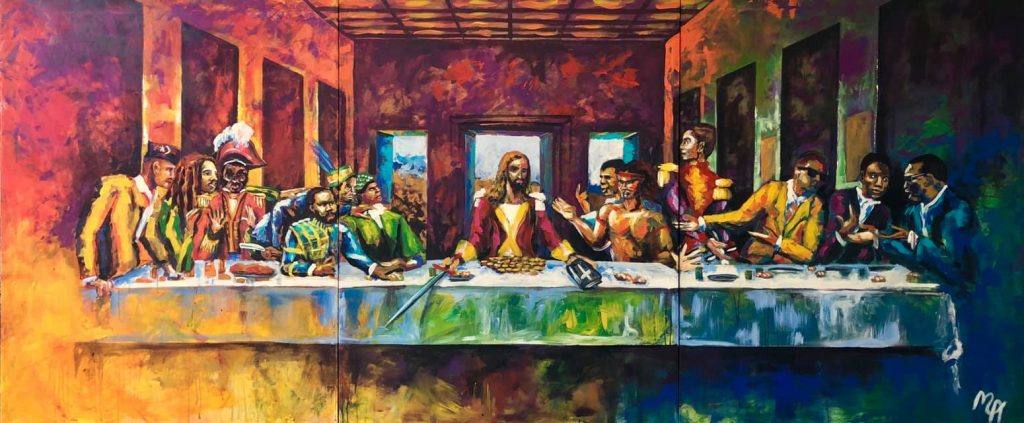
Triptych 42” x 54” (126”W x 54” H)
A conversation on resistance featuring Elijah Muhammed, Bob Marley, Jean-Jaques Dessaline, Marcus Garvey, King Court Takey (Prince Klaas), Harriet Tubman, Joseph Chatoyer, Simon Bolivar, Dr Eric Williams, Paul Bogle and Louis Farrakhan
Calvert Jones Art (Masterpiece Series)
The Last Colonial Meal
By Calvert Jones
The Last Colonial Meal is a contemporary adaption of Leonardo Da Vinci’s Masterpiece, The Last Supper, presented in a stunningly colourful rendition of past and present advocates in the struggle against a plethora of socio-economic issues and injustices in the quest for inalienable rights and freedoms across our Western Society.
The Artwork’s geometry of a combined three panels, each 42cm W x 54cm H and 126 pixels per cm, mirror the importance of the 3-6-9 mathematical principles of our conscious reality. The entire vertical and horizontaldimension as well as the resolution has digits that if added together sum up to the single digit “9”. If youmultiply each, the vertical and horizontal dimensions, then add the resulting digits and reduce them to a single digit, you also get a “9”. No other number has that quality and even the math of its dimensions, highlights a philosophical observation that is unique, interesting and very revealing.
According to Numerology, number 9 has a concern for the welfare of humanity. There’s an absence of prejudice and judgement, a tendency to be compassionate, tolerance of religions and lifestyles, and philanthropy for the welfare of people and the accomplishment of an idealistic vision. The number 9 is considered to be the mosthumanitarian number of all.
The painting, like the unique intrigue surrounding its dimensions, is both visually captivating as it is conversational and conceptual. It is limited in size yet unlimited in the scope of understanding, tangible in its three part yet intangible in the third eye of understanding, physical in appearance yet psychological and spiritual in meaning andvalue, historical in past references yet charting a message for the future.
The artwork done in the personal painting style coined by the Artist – Calvert Jones – as Tropical Realism, a unique blend of impressionism, fauvism, pop art and expressionism, with bold colors strewn with loose and flowingbrush strokes across a cosmopolitan-colored backdrop of the range of visible light. Digital enhancements to lightingand depth differentiate this NFT from the original painting – another dimension of metaphorical significance.
The painting intriguingly draws the observer into focusing on the central character in 18th Century British Military Regalia, who though not Jesus, is deliberate in the contradictory presentation of Jesus’s widely accepted likeness –a pictorial challenge to our narrative fallacy. Instead, this figure represents the depiction of the three pillars through which Colonialism and Imperialism have presented their faces to Western Man, both past and present. These pillars are in the form of War, symbolized by the sword, Economic pillaging symbolized by the thirty pieces ofgold and religious mollification, symbolized by the Bible.
The central character is surrounded by twelve (12) past and present proponents who, while real, are alsoallegorical in their representations with their placements mirroring the positions of all characters in the Da Vinci Masterpiece “The Last Supper”.
These figures from left to right are:
- Elijah Muhammad based on his proliferation of the message of Black Unity, financial independence, self-help and a strict code of moral conduct among the Black Community rather than confrontation and forced integration between the races.
- Robert Nesta Marley, “Bob Marley” was chosen for several
- As a symbol for the role of the creative industry in influencing a generation and how it can contribute to the message of hope, unity, peace and love.
- Humble beginnings or being considered part of the rejected class of society don’t define your limitations and vision for yourself;
- His role as a Rastafari, who promoted conscious living and the usefulness of the marijuana for both physical healing and spirituality. This is very important from the context that many black and colored males have been disproportionately incarcerated (especially in North America) for drugoffenses affecting the family structure and economic balance in their communities, yet today, this same plant is being decriminalized based on new research in the several medicinal benefits it presents.
- Jean -Jacques Dessalines was an instrumental representative for the significance of revolutionary pursuits, constitutional reform and liberation in the process of self- determination, freedom and independence.
- Prince Klaas is present and he’s holding a knife in his hidden hand ready to consider aggression as a possible solution to There is a time for everything and as his legacy is written, while his plans wereelaborate and commendable, it wasn’t successful because timing is also key.
- Marcus Garvey popularly known as “Black Moses” was a key figure in Western History and started one of the largest organized mass movements in black history and was a progenitor of the modern “black is beautiful”ideal of racial pride and the psychological
- Harriet Tubman is important for her role in the liberation of not just physical chains but mental chains. One of her greatest quotations demonstrates the denial in which People who are mentally enslaved exist. Her role as one of the founding members of the Women’s Suffrage Movement was also critical. She was also used in this position of Mary Magdalene and is the only woman as in the original masterpiece.
Characters on the right side of the central character:
- Joseph Chatoyer was used as a symbol of National Pride, personal excellence, leadership, diplomacy and vision and the historical representative of the indigenous Peoples of the Western His legacy in forcingthe British to sign a treaty in 1773 with St. Vincent and the Grenadines is a stark reminder of the legacy ofthe indigenous and colored People to organize and negotiate terms of agreement.
- Booker Taliaferro Washington was important among these characters as he represented a voice for the Being part of the last generation in the United States born into slavery, he’s considered theforerunner to most civil rights movements and his lifelong achievements would be considered extraordinaryas he rose to become a progressive voice for entrepreneurship in the Black Community
- Simón José Antonio de la Santísima Trinidad Bolívar Palacios Ponte y Blanco, generally known as Simón Bolívar was included because of the role enlightenment played in his quest to liberate Venezuela, Bolivia, Colombia, Ecuador, Peru, and Panama. His role highlights the important of consciousness,psychological healing, knowledge and civic virtue among His position and readiness to draw his sword as displayed in the painting, calls to the forefront the decisiveness of the actionthat is needed.
- The Hon. Dr. Eric Eustace Williams’ inclusion was symbolic of how the usage of pragmatic socialism, could be used as a possible tool for community advancement, improved education, and economicdevelopment through the cautious attraction of foreign investment capital. The policy was fruitful in making Trinidad and Tobago the wealthiest Commonwealth Caribbean nation and is a modern demonstration of how a Country can defy challenges and chart its own success.
- Paul Bogle represents the necessity of defying the status quo. Whether it be for equality and justice against any system of oppression, particularly the systems of classism, racism and elitism that exists throughout the Western World.
- Louis Farrakhan’s importance in this lineup was critical because he organized one of the largest peaceful marches in American History of approximately 1.1 million men stressing the importance of the family structure and spiritual renewal.
This painting, through its baiting of narratives, biases, emotions and controversy is in actuality a harbinger of hopeand unity. Hope that we can all have our conversations presented at the table, devoid of pretenses, biases and discrimination to chart a new way forward so we can all live and thrive together.
This painting is living, moving and ever evolving conversational piece that goes beyond what is represented to questions on what isn’t. A facilitator of the tough questions and discussions and negotiations we need to have. Aswith the table – it is single just like our planet is single, and we are all connected.

